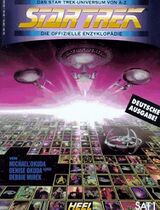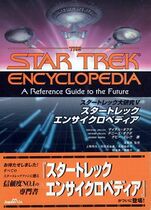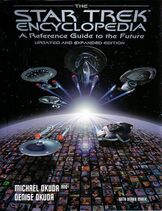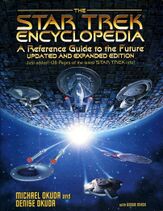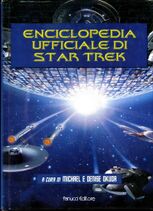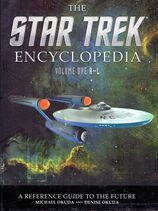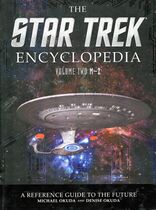Star Trek Encyclopedia
| Real-World |
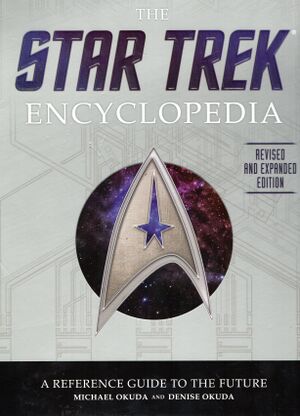 Fourth edition slipcase cover | |
| Author | Michael Okuda and Denise Okuda, with Debbie Mirek |
|---|---|
| Illustrator | Doug Drexler, Gary Hutzel, Ed Miarecki, Anthony Fredrickson, Fabio Passaro |
| Published | First edition: 1 May 1994 January 1995 (Germany) August 1998 (Japan) Second edition: 1 December 1997 Third edition: 1 October 1999 February 2001 (Italy) 10 April 2003 (Japan) May 2011 (eBook) Fourth edition: 18 October 2016 |
| Publisher | Pocket Books becker&mayer! (4th edition) Heel (Germany) Fanucci Editore (Italy) Japan Mix, Inc. (Japan 1st edition) Dai-X (Japan) |
| Pages | 400 (1st ed, 364 Germany, 495 Japan) 640 (2nd ed.) 745 (3rd ed, 794 Italy, Japan) 1,056 (4th ed.) |
| ISBN | 0671869051 |
The Star Trek Encyclopedia – A Reference Guide to the Future is the "definitive" Star Trek reference book, compiled by the production staff and officially licensed and endorsed by Paramount Pictures/CBS Consumer Products.
An A-Z encyclopedia covering subjects from Andorians to Zefram Cochrane to Atoz, the Star Trek Encyclopedia was compiled by Star Trek: The Next Generation, Star Trek: Deep Space Nine, and Star Trek: Voyager staffers Denise and Michael Okuda. With artwork from, among others, Doug Drexler, it includes summaries of all episodes, descriptions of all characters, rundowns of all locations, data on all lifeforms, and details on all starships that appeared in the Star Trek universe.
Summary[edit | edit source]
- From the interior book jacket (3rd edition)
- From 'audet IX [sic] to Zytchin III, this book covers it all. This is the ultimate reference book for all Star Trek fans!
- Added to this edition are 128 new pages. This addendum highlights the latest episodes of Star Trek: Deep Space Nine, Star Trek: Voyager and the newest feature film, Star Trek: Insurrection.
- The thousands of photos and hundreds of illustrations place the Star Trek universe at your fingertips, Planets and stars, weapons and ships, people and places are just part of the meticulous research and the countless cross-references that fill this book.
This article contains excerpts of copyrighted sources which are included for review purposes only, without any intention of infringement. |
Background information[edit | edit source]
- Articles generally comprise one or two paragraphs. Some contain behind-the-scenes information, annotated in italicized fonts to distinguish them from the in-universe approach of the work. Many also feature images created specifically for the Encyclopedia, including shots of barely visible starships like the Saber-class and Norway-class vessels, and a photograph of Cochrane's statue.
Editions[edit | edit source]
- The first edition of the Encyclopedia was published in black and white, and in both hardcover and softcover formats. It contained material from Star Trek: The Original Series, the first six Star Trek movies, Star Trek: The Next Generation to partway through season 7, and part of Star Trek: Deep Space Nine season 1. This edition was translated into Japanese and German (1995, published by Heel).
- The second edition saw the Encyclopedia published in full color. It was only published in hardcover format. It added information from the remainder of TNG Season 7, Star Trek Generations, Star Trek: First Contact, Deep Space Nine to partway through season 5 and Star Trek: Voyager to partway through season 3.
- The third edition of the Encyclopedia retained the full-color format, and had both hardcover and softcover releases. However, this edition took a different approach to its update – which covered Star Trek: Insurrection, Deep Space Nine to partway through season 7 (but with main character details covering the final episodes) and Voyager to partway through season 5 – as it was provided in a 128-page appendix to the second edition material. This was a cost-saving measure, as integrating this information alphabetically into the existing material of the second edition would have resulted in a greater publishing expense and thus a higher price. This edition was released in hardcover in Japanese and Italian (translated from English by Massimiliano Antonioli for Fanucci Editore as the Enciclopedia ufficiale di Star Trek). Both of these editions contained fifty pages of additional material over their English-language source publication.
- The fourth edition of the Encyclopedia, released in October 2016 to coincide with the 50th anniversary of Star Trek, comprises two hardcover volumes, without dustjackets, in a hardboard slipcase. Produced by becker&mayer! and published by HarperCollins Publishers, this new, entirely revised edition – the first in seventeen years – includes three hundred new pages covering the remainder of the last season of Deep Space Nine, the remaining three seasons of Voyager, the entirety of Star Trek: Enterprise, Star Trek Nemesis, as well as incorporating information derived from the first two alternate reality movies, Star Trek and Star Trek Into Darkness – not as a separate appendix as reported prior to the release; entries pertaining to the alternate universe are addended with an "*". (introduction; [1])
- That a fourth print edition had even been commissioned came as much as a surprise to its authors as it had been to fans; "Ever since 1999, one of the questions we've heard most often from fans has been, "When will there be a new edition of The Star Trek Encyclopedia?" The truth was that the book industry has changed a lot and we feared that with each passing year, a new edition was becoming increasingly unlikely. We really had no idea of when (or if) it could ever happen. You can imagine our shock and delight when John Van Citters of CBS Consumer Products and Dana Youlin of becker&meyer! told us that Harper Collins had stepped up to the plate to take on this challenge," the elated authors stated in the introduction.
- While many illustrations pertaining to contents already covered in the previous edition were ported over, many were also replaced with new imagery for the new edition. Especially noteworthy were the starship images, originally done as graphics by Doug Drexler, that were now replaced by CGI imagery as originally constructed by Fabio Passaro for the British Star Trek: The Official Starships Collection partwork publication, for whom Mike Okuda has volunteered consultancy services. Passaro and his consigner Ben Robinson (project manager of the "Collection") have been dutifully acknowledged in the new edition.
Sources and usage[edit | edit source]
- The Encyclopedia was essentially a byproduct from the extensive research the authors had already performed for the Star Trek Chronology, the first edition of which was published one year prior to that of the Encyclopedia. "We again worked by episode, but used the scripts as a reference tool (once they were matched to the aired version of the episode). We catalogued terms, not just chronological data. We did the chronology for the sake of the chronology...it was only afterwards that the idea for the encyclopedia came up.", original Co-author Debbie Mirek clarified. [2] Still, while the Encyclopedia has been updated, it remains unlikely the Chronology source publication will receive a similar treatment, and the Okuda author couple implicitly conceded this, as, starting with the third edition, the Encyclopedia incorporated updated, albeit severely truncated, three-page Star Trek time-line appendices.
- As with its progenitor, not taken into account were officially licensed non-live action works – such as the various Star Trek novels, comics, and games, which are considered apocryphal; nor was Star Trek: The Animated Series, which was considered non-canon at the time of writing the Encyclopedia, or any previously licensed in-universe reference work which had hitherto been considered "official". Mirek commented, regarding the Animated Series: "I am not really sure why it was discounted. I believe Roddenberry did not like the animated series, and Michael, who respected the man enormously, valued his opinion. Gene was largely out of the loop for TNG, in my opinion, so what happened with Star Trek II: The Wrath of Khan and onward, shouldn't be attributed to him. Mike worked on all those films, and they have to be recognized as part of the "universe"." [3] Even though the official franchise has since then elevated The Animated Series to canon, Okuda has maintained his stance for the 2016 fourth edition, as stated in that edition's introduction and despite remaining an Animated Series fan himself.
- As of 2002, the official Star Trek franchise treats the Chronology, the Encyclopedia and the 1991 Star Trek: The Next Generation Technical Manual (co-written by Mike Okuda) as the sole primary reference sources (beyond the episodes/movies themselves) for all subsequent in-universe reference works; as such these three works are elevated to the status of "quasi-canon". Licensed works of this kind – such as the later GE Fabbri, Haynes Publishing and Eaglemoss Collections (publisher of the aforementiond Starships Collection) Star Trek publications – are required to be in concordance with the information contained within these three works, with the Okuda author couple not rarely assigned to these later publications as "technical consultants" to ensure compliance. As a consequence, all previously licensed reference works written from an in-universe perspective were no longer considered official references – most notably Franz Joseph's Star Fleet Technical Manual as well as Shane Johnson's Mr. Scott's Guide to the Enterprise and Worlds of the Federation – and no information from these was taken into account in either the Encyclopedia or the Chronology. Labeled "unofficial", these works were de facto debunked and demoted by the franchise to the apocryphal status of novels, comics, non-production art (such as Star Trek: Ships of the Line calendars) and (computer)games. (Star Trek: The Magazine Volume 2, Issue 11, p. 71) Greg Jein's "The Case of Jonathan Doe Starship" article, written as a fan two decades earlier, was the only unofficial source acknowledged in the Encyclopedia (1994, p. 57; 1999, pp. 85-86). The Constitution-class registries in the Encyclopedia are largely based on this article, starting their journey to elevation into canon.
- Though for the most part adhering to what was canonically established, there was some conjecture included in the Encyclopedia, aside from some of the Constitution-class registries, as the authors made several references to material that was never explicitly noted in canon (i.e. made up exclusively for the Encyclopedia) or that came from unspecified materials that have yet to be identified on screen. The vast majority of these references were the registries, class designations, and some of the classes themselves assigned to Federation starships which were identified on screen by name only, be it orally or visually. Classes noted as conjectural are listed below.
- While the authors had incorporated some conjectural historical information in their earlier Chronology, mostly pertaining to early non-canonically established Star Trek history, they refrained from including most of that information in the Encyclopedia, strictly adhering to what was established on screen. However, there were two noticeable exceptions; the designs of the SS Valiant and the Daedalus-class of which Jein had built reference models for representation in the Chronology. Both were also visually represented in the Encyclopedia, as Okuda and Drexler championed their elevation into canon, that of the Daedalus-class in particular. The latter at least managed to make on-screen appearances as a display model, though the link between class-name and appearance remained unestablished. See: Daedalus class model for further information.
- Memory Alpha was not used for research when compiling the 2016 edition, the authors citing integrity reasons, "Any mistakes have to be our mistakes". [4]
- There are indeed a few errors still in existence here and there in the 2016 edition. For example, at least two errors exist in the illustrated table for the various shuttlecraft. The in-universe date of the production of the very first shuttle for the Enterprise-D is the same year as that of a shuttle featured in Star Trek V, which is questionable since TNG starts 78 years later. A typo is present regarding the last shuttlecraft at the bottom of the page, for Star Trek: Voyager – the year has been given five digits. A few errors detected elsewhere also, including the mention of an appearance of a Ferengi Marauder vessel in the TNG episode “Rascals”, which is not the case. No such vessel was featured in that episode – the Ferengi "pirates" arrived on board an apparently stolen Klingon Bird-of-Prey. The K't'inga-class Klingon battle cruiser is indicated as having first appeared in the 23rd century, although one such ship was featured on Star Trek: Enterprise (“Unexpected”), which takes place in the 22nd century.
- Apart from the few mistakes, there are also a few canon entry omissions, "Starfleet Medical" being one of the more notable ones.
Conjectural ship classes[edit | edit source]
The following classes appeared in the Star Trek Encyclopedia and are noted as conjectural, but not on what basis. Rigel-class and Yosemite-class were mentioned on a Starfleet Operations chart in “Brothers”:
Cover gallery[edit | edit source]
Further reading[edit | edit source]
- "Star Trek Encyclopedias", Star Trek: The Magazine Volume 1, Issue 4, pp. 90-91
See also[edit | edit source]
External link[edit | edit source]
- Star Trek Encyclopedia at Memory Alpha, the wiki for canon Star Trek.
- Star Trek Encyclopedia at Memory Beta, the wiki for licensed canon & non-canon Star Trek works.

